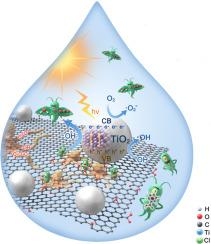合成-酸度调节TiO2@GO与丰富的官能团有效光降解微量污染物
IF 7.1
Q1 ENGINEERING, CHEMICAL
引用次数: 0
摘要
随着环境污染的日益严重,微量污染物的去除已成为水处理领域的关键挑战。TiO2@GO-based催化剂表现出优异的光降解性能,但目前的研究主要集中在研究氧空位的功能,而忽略了其他潜在因素,如氧化石墨烯的作用,阻碍了对TiO2@GO-based催化剂的全面了解。为了解决这个问题,我们提出了一种简单的一锅溶胶-凝胶方法,通过调节合成酸度来调节催化剂的性能。采用透射电镜(TEM)、x射线衍射(XRD)、x射线光电子能谱(XPS)、电子顺磁共振(EPR)和拉曼光谱对合成催化剂的理化性质进行了综合表征。考察了系列TiO2@GO催化剂的氧空位和表面官能团密度,以及它们对靛蓝胭脂红的光降解性能。随着合成酸度的增加,表面氧空位比例呈增加-减少的趋势,在0.1 mol l-1 HCl处达到最大值;而表面官能团密度和光催化靛蓝胭脂红效率则呈减少-增加-减少的趋势,在0.1 mol l-1 HCl处达到峰值,但总体规律不同。除了众所周知的氧空位增强光催化降解外,官能团在TiO2@GO表面的吸附作用更为显著。此外,TiO2@GO还通过常见的微量污染物和自由基探针对氯苯甲酸(pCBA)表现出促进的光降解性能和羟基自由基降解机制。密度泛函理论计算进一步表明,表面官能团会显著增强TiO2@GO对pCBA的吸附,从而提高其光降解性能。我们的研究为理解如何增强TiO2@GO-based催化剂的表面功能化有助于提高光催化活性提供了新的视角。本文章由计算机程序翻译,如有差异,请以英文原文为准。

Synthesis-acidity modulated TiO2@GO with enriched functional groups for efficient photodegradation of trace contaminant
As environmental pollution gets increasingly severe, the removal of trace contaminants has become a critical challenge in the field of water treatment. TiO2@GO-based catalysts have exhibited excellent photodegradation performance, but so far, current research mainly focuses on investigating the function of oxygen vacancies while overlooking other potential factors, such as the role of GO, which hindered comprehensive understanding of TiO2@GO-based catalysts. To address this, we propose a simple one-pot sol-gel method, where the catalyst properties are tuned by adjusting the synthesis acidity. Transmission electron microscopy (TEM), X-ray diffraction (XRD), X-ray photoelectron spectroscopy (XPS), Electron paramagnetic resonance (EPR), and Raman spectroscopy were employed to comprehensively characterize the physicochemical properties of the synthesized catalysts. Both the oxygen vacancy and surface functional group densities of the serial TiO2@GO catalysts, as well as their photodegradation performance of indigo carmine are investigated. With increasing synthesis acidity, the surface oxygen vacancy proportion showed an increase–decrease pattern with a maximum at 0.1 mol l-1 HCl, while the surface functional group density and photocatalytic efficiency toward indigo carmine exhibited a decrease-increase-decrease trend, also peaking at 0.1 mol l-1 HCl but following a different overall pattern. Besides the common understanding that oxygen vacancies enhance photocatalytic degradation, the adsorption effects of functional groups on TiO2@GO surface proved to be more significant. Additionally, TiO2@GO also exhibits promoted photodegradation performance and a hydroxyl radical degradation mechanism via a common trace contaminant and radical probe, para-chlorobenzoic acid (pCBA). Density functional theory calculations further reveal that the surface functional groups would significantly enhance the adsorption of pCBA on TiO2@GO, thereby improving their photodegradation performance. Our study provides new perspectives on understanding how enhancing the surface functionalization of TiO2@GO-based catalysts helps to improve photocatalytic activity.
求助全文
通过发布文献求助,成功后即可免费获取论文全文。
去求助
来源期刊

Chemical Engineering Journal Advances
Engineering-Industrial and Manufacturing Engineering
CiteScore
8.30
自引率
0.00%
发文量
213
审稿时长
26 days
 求助内容:
求助内容: 应助结果提醒方式:
应助结果提醒方式:


